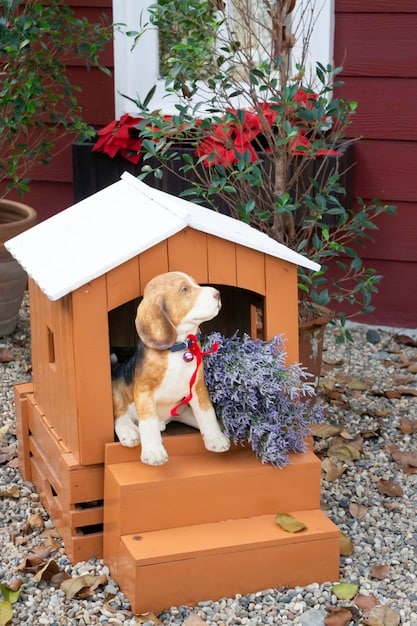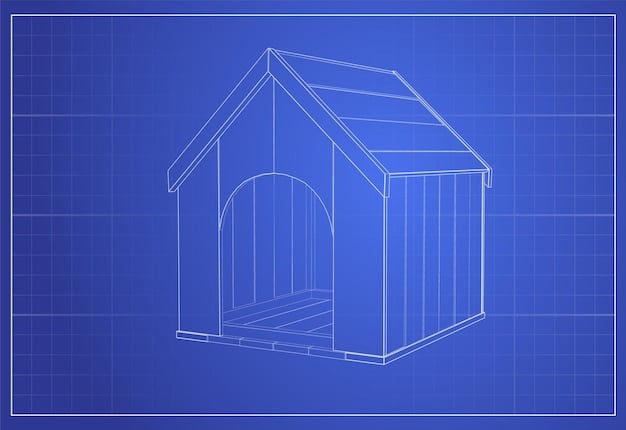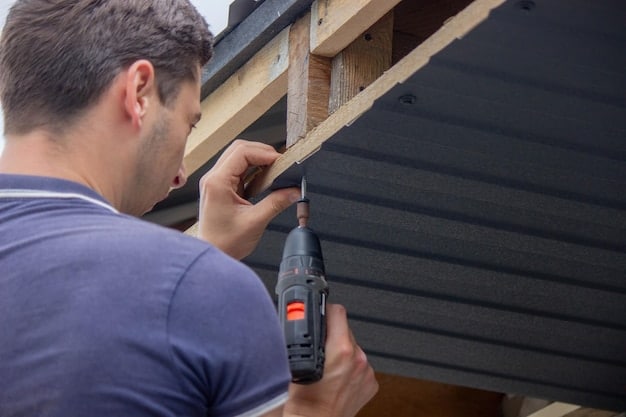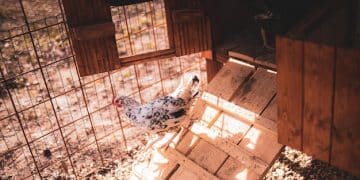Build a Dog House: A Weekend DIY Project for Your Furry Friend

Building a dog house is a fulfilling weekend DIY project, providing your furry friend with a secure, comfortable shelter tailored to their needs, while enhancing your home improvement skills and adding a personalized touch to your backyard.
Looking for a rewarding weekend DIY project that will make your furry friend incredibly happy? Build a dog house for your furry friend: a weekend project for pet owners is the perfect solution! Not only will you provide your beloved pet with a safe and comfortable shelter, but you’ll also enjoy the satisfaction of creating something special with your own hands.
Why Build a Dog House? Benefits and Considerations
Building a dog house can be a fantastic way to provide your pet with a secure and comfortable space. A well-designed dog house offers protection from the elements, a sense of security, and a personal retreat for your furry friend.
Beyond the obvious benefits, there are several key considerations to keep in mind before you start hammering away. Let’s explore the advantages and important factors to ensure your DIY project is a success.
The Benefits of a Dog House
A dog house provides numerous advantages for your pet:
- Protection from the elements: A sturdy dog house shields your dog from rain, snow, wind, and harsh sunlight, keeping them comfortable year-round.
- A sense of security: Dogs feel safe and secure in their own den-like space, reducing anxiety and providing a place to retreat when they feel overwhelmed.
- Personal space: Just like humans, dogs need their own space to relax and unwind. A dog house offers a private retreat where they can rest undisturbed.
Key Considerations Before Building
Before you dive into building, consider these important factors:
- Size: The dog house should be large enough for your dog to stand up, turn around, and lie down comfortably, but not so large that it loses heat in the winter.
- Materials: Choose durable, weather-resistant materials that are safe for your dog and easy to work with.
- Location: Place the dog house in a sheltered area of your yard, away from direct sunlight and strong winds.
- Insulation: Consider adding insulation to the dog house to keep it warm in the winter and cool in the summer.
By carefully considering these factors, you can create a dog house that perfectly meets your pet’s needs and provides them with a comfortable and secure home away from home.
Planning Your Dog House: Design and Size
Proper planning is crucial for a successful dog house build. Careful consideration of the design and size will ensure your furry friend has a comfortable and functional shelter.
This section will guide you through the essential steps of designing your dog house, including choosing the right size and style to suit your dog’s needs and your aesthetic preferences.
Choosing the Right Size
The size of your dog house is paramount to its comfort and functionality. Here’s how to determine the ideal dimensions:
- Measure your dog: Measure your dog from nose to tail, and from shoulder to the top of their head. Add a few inches to each measurement to allow for comfortable movement.
- Height: The height of the dog house should be about 25% taller than your dog’s shoulder height.
- Width and Depth: The width and depth should be about 25% longer than your dog’s length.
Selecting a Design Style
There are various dog house designs to choose from, each with its own advantages:
- Basic Shed Style: This simple design is easy to build and provides ample space for your dog.
- A-Frame Style: The A-frame design is aesthetically pleasing and offers good weather protection.
- Insulated Dog House: Ideal for colder climates, an insulated dog house keeps your dog warm and comfortable in the winter.

Remember to consider your dog’s breed, size, and climate when choosing a design style. A well-planned dog house will provide years of comfortable shelter for your beloved pet.
Essential Tools and Materials for Your Build
Before starting any DIY project, it’s essential to gather the necessary tools and materials. Having everything on hand will ensure a smooth building process and a professional-looking final product.
This section outlines the tools and materials you’ll need for building your dog house, providing a comprehensive checklist to help you get prepared.
Required Tools
Here’s a list of essential tools you’ll need:
- Measuring tape: For accurate measurements.
- Saw (circular or hand saw): For cutting wood.
- Drill with various bits: For drilling holes and driving screws.
- Hammer: For driving nails.
- Screwdriver: For driving screws manually.
- Safety glasses: To protect your eyes.
- Work gloves: To protect your hands.
Essential Materials
Gather these materials before you begin:
- Wood (plywood or cedar): For the frame and walls.
- Fasteners (nails or screws): For joining the wood pieces.
- Waterproof sealant: To protect the wood from moisture.
- Insulation (optional): For added warmth in colder climates.
- Roofing material (shingles or tar paper): To protect the roof from the elements.
- Paint or stain (optional): To add a personal touch and protect the wood.
By gathering all the necessary tools and materials beforehand, you’ll be well-prepared to tackle your dog house project with confidence and efficiency.
Step-by-Step Guide to Building Your Dog House
Now that you have your plan, tools, and materials, it’s time to start building! This step-by-step guide will walk you through the process of constructing your dog house, from framing to finishing.
Follow these instructions carefully and you’ll have a sturdy and comfortable shelter for your furry friend in no time.
Step 1: Cut the Wood
Using your measurements and saw, cut the wood pieces for the frame, walls, floor, and roof. Ensure the cuts are accurate for a snug fit.
Step 2: Assemble the Frame
Construct the frame by joining the wood pieces with nails or screws. Make sure the frame is square and sturdy.
Step 3: Attach the Walls and Floor
Attach the plywood or cedar walls to the frame using nails or screws. Then, attach the floor to the bottom of the frame.

Step 4: Build and Attach the Roof
Build the roof frame and cover it with plywood or cedar. Attach the roofing material (shingles or tar paper) to protect it from the elements. Then, attach the roof to the frame.
Step 5: Apply Sealant and Paint
Apply waterproof sealant to all seams and joints to prevent moisture from entering the dog house. Once the sealant is dry, paint or stain the dog house to add a personal touch and protect the wood.
With these steps, you’ll have a functional and attractive dog house ready for your pet to enjoy. Remember to take your time and ensure each step is completed accurately for a long-lasting result.
Customizing Your Dog House: Adding Personal Touches
Once the basic structure of your dog house is complete, it’s time to add personal touches to make it truly special for your furry friend. Customizing your dog house can make it more comfortable, functional, and aesthetically pleasing.
This section explores various ways to customize your dog house, from adding insulation to creating a stylish exterior.
Adding Insulation
Insulation is essential for keeping your dog house warm in the winter and cool in the summer. Consider these insulation options:
- Foam board insulation: Easy to cut and install, foam board provides excellent insulation.
- Fiberglass insulation: A cost-effective option, fiberglass insulation should be covered to prevent your dog from inhaling the fibers.
- Reflective bubble wrap insulation: This lightweight material reflects heat and is easy to install.
Creating a Stylish Exterior
Add a personal touch to your dog house with these exterior enhancements:
- Paint or stain: Choose colors and finishes that complement your home and yard.
- Decorative trim: Add trim around the door and windows for a polished look.
- Personalized nameplate: Create a nameplate with your dog’s name for a personal touch.
By adding insulation and customizing the exterior, you can create a dog house that is both comfortable and stylish, providing your pet with a cozy and personalized retreat.
Maintaining Your Dog House: Tips for Longevity
Proper maintenance is key to ensuring your dog house lasts for years to come. Regular cleaning and upkeep will keep it in good condition and provide a healthy environment for your pet.
This section offers practical tips for maintaining your dog house, helping you protect your investment and keep your furry friend comfortable.
Regular Cleaning
Clean the dog house regularly to prevent the buildup of dirt, debris, and parasites:
- Remove bedding and wash it frequently.
- Sweep or vacuum the interior of the dog house to remove loose dirt and debris.
- Disinfect the interior with a pet-safe cleaner.
Routine Inspections
Inspect the dog house regularly for signs of damage or wear:
- Check for leaks and repair them promptly.
- Inspect the wood for rot or insect damage.
- Ensure the insulation is in good condition and replace it if necessary.
By following these maintenance tips, you can extend the life of your dog house and provide your pet with a clean, safe, and comfortable shelter for years to come.
| Key Point | Brief Description |
|---|---|
| 📏 Size Matters | Ensure the dog house is appropriately sized for your dog to move comfortably. |
| 🔨 Material Choice | Opt for durable, weather-resistant, and dog-safe materials like cedar or treated plywood. |
| 🛡️ Weather Protection | Use proper sealing and roofing to protect from rain, wind, and sun. |
| 🏠 Customization | Add insulation, paint, or a nameplate for a personalized touch. |
Frequently Asked Questions
▼
The ideal size allows your dog to stand, turn, and lie down comfortably. Measure your dog and add about 25% to their height and length for the right dimensions.
▼
Durable, weather-resistant materials like cedar and treated plywood are excellent choices. Ensure they are safe and free from harmful chemicals or treatments.
▼
Insulation is crucial, especially in extreme climates. It helps keep the dog house warm in winter and cool in summer, providing year-round comfort.
▼
Place the dog house in a sheltered area, away from direct sunlight, strong winds, and heavy rain. A location near your house can also provide added security.
▼
Clean the dog house regularly, at least once a month, to remove dirt, debris, and potential parasites. Wash bedding frequently and disinfect the interior as needed.
Conclusion
Building a dog house for your furry friend is a rewarding project that enhances their comfort and security. By considering the right size, materials, and design, you can create a personalized shelter that your dog will love for years to come. Remember to maintain the dog house regularly to ensure a clean and safe environment.





